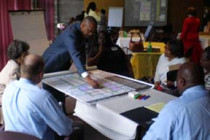Vine Street Economic Development Plan
Client: City of Kansas City, Missouri
Project: Vine Street Economic Development Plan
Year: 2010
Awards:
Special Community Initiative -2011 Missouri State Chapter,
American Planning Association
Merit Award -American Society of Landscape Architects-
Prairie Gateway Chapter
Award of Excellence - 2011 Central States Regional Design Award,
American Society of Landscape Architects
Project Description:
The Vine Street Economic Development Plan is the first districtplan in Kansas City, Missouri, to focus on strategies for the economic development health of a specific community. There is no other comparable group of neighborhoods in the city that embody the unique African-American history and experience as the Vine Street District does, defined as the historic area between 9th Street and 29th Street, Troost Avenue to Prospect Avenue.
A unique set of circumstances – born of racial prejudice – created the vibrant cultural and family environment enjoyed by this area from the late 1800’s through the 1950’s. An equally unique set of factors and government policies sent it spiralinginto neglect and decay from the 1950’s to 2010.
This three square mile area has lost 84% of its population since 1950, including a net loss of 80% of the District’s housing stock. Approximately 80% of the remaining housing stock is renteroccupied.
Of all housing units within the District, approximately 20% are vacant. The median value for owneroccupied homes is 57% of the citywide median value. Portions of the District have the City’s highest
housing foreclosure rates.Nearly 90% of its population is African-American compared to30% citywide. The District poverty level is 35% compared tocitywide average of 16%.
The plan, generated by robust community involvement, a special cohesive strategy to guide future public and private economic development efforts in the district,with specific action plans for housing and commercial revitalization. It outlines the strategies,recommendations and action steps required togenerate a multi-faceted revitalization of this central city community, so that it once again becomes a vital contributing part of Kansas City’s economy and quality of life.




